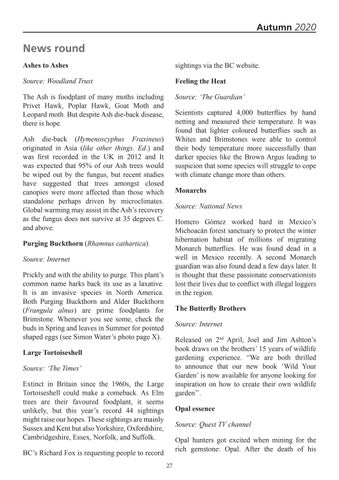Autumn 2020
News round Ashes to Ashes
sightings via the BC website.
Source: Woodland Trust
Feeling the Heat
The Ash is foodplant of many moths including Privet Hawk, Poplar Hawk, Goat Moth and Leopard moth. But despite Ash die-back disease, there is hope.
Source: ‘The Guardian’ Scientists captured 4,000 butterflies by hand netting and measured their temperature. It was found that lighter coloured butterflies such as Whites and Brimstones were able to control their body temperature more successfully than darker species like the Brown Argus leading to suspicion that some species will struggle to cope with climate change more than others.
Ash die-back (Hymenoscyphus Fraxineus) originated in Asia (like other things. Ed.) and was first recorded in the UK in 2012 and It was expected that 95% of our Ash trees would be wiped out by the fungus, but recent studies have suggested that trees amongst closed canopies were more affected than those which standalone perhaps driven by microclimates. Global warming may assist in the Ash’s recovery as the fungus does not survive at 35 degrees C. and above.
Monarchs Source: National News Homero Gómez worked hard in Mexico’s Michoacán forest sanctuary to protect the winter hibernation habitat of millions of migrating Monarch butterflies. He was found dead in a well in Mexico recently. A second Monarch guardian was also found dead a few days later. It is thought that these passionate conservationists lost their lives due to conflict with illegal loggers in the region.
Purging Buckthorn (Rhamnus cathartica) Source: Internet Prickly and with the ability to purge. This plant’s common name harks back its use as a laxative. It is an invasive species in North America. Both Purging Buckthorn and Alder Buckthorn (Frangula alnus) are prime foodplants for Brimstone. Whenever you see some, check the buds in Spring and leaves in Summer for pointed shaped eggs (see Simon Water’s photo page X).
The Butterfly Brothers Source: Internet Released on 2nd April, Joel and Jim Ashton’s book draws on the brothers’ 15 years of wildlife gardening experience. “We are both thrilled to announce that our new book ‘Wild Your Garden’ is now available for anyone looking for inspiration on how to create their own wildlife garden’’.
Large Tortoiseshell Source: ‘The Times’ Extinct in Britain since the 1960s, the Large Tortoiseshell could make a comeback. As Elm trees are their favoured foodplant, it seems unlikely, but this year’s record 44 sightings might raise our hopes. These sightings are mainly Sussex and Kent but also Yorkshire, Oxfordshire, Cambridgeshire, Essex, Norfolk, and Suffolk.
Opal essence Source: Quest TV channel Opal hunters got excited when mining for the rich gemstone: Opal. After the death of his
BC’s Richard Fox is requesting people to record 27




